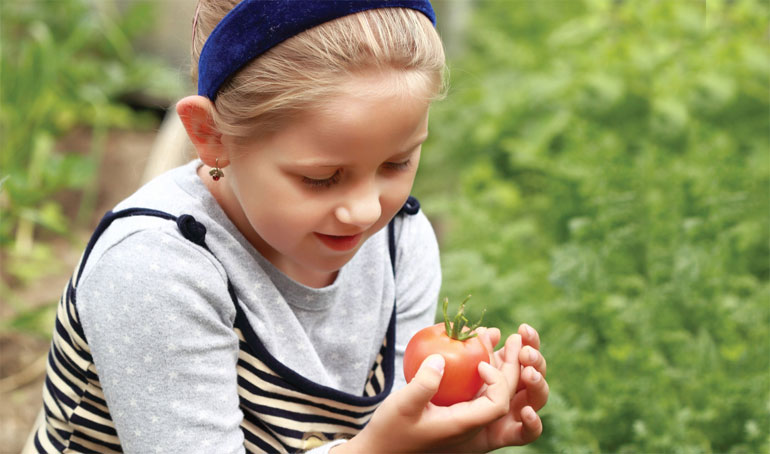Grow more than vegetables.
Cultive más que vegetales
By Laura Saavedra
Growing your own vegetables and fruits is not only good for your budget, but it can also be extremely relaxing and entertaining. Working in the garden is an activity where the whole family can get involved. It also creates the opportunity for children to spend quality time with parents. Here are some steps to consider when creating your own garden and how to be successful.
Garden size
It is better to start with a small space and enlarge it in the following years, once you have more experience and can see more clearly what you want from your own garden. It is better to be proud of a small garden than to be frustrated by a large one that didn’t achieve the desired outcome.
• Pots: If you don’t have a green space for gardening, you can make a garden on your balcony or deck in large pots. If you grow tomatoes, keep in mind that the plant is probably going to be smaller than one planted in the ground.
• Elevated boxes: These structures help to obtain better results than planting directly on the ground because they form an insulation that prevents the growth of weeds. You can also buy a thin plastic fabric that prevents weeds from growing. Put this cloth down as a base before adding your soil. If you decide to make your own box for planting, consider using whole wood (not treated wood as it has harmful chemicals). A height of 10 inches will be enough for common plants or 20 inches if you are going to plant potatoes, carrots, or radishes. The raised boxes also allow for better separation and irrigation.
Good land
This is the key to a great garden. Keep in mind that soil may contain harmful chemicals or metals, so elevated boxes or pots are recommended.
If you are aiming to make an organic garden, look for certified organic soil and mix it with compost in the spring or autumn to give the beneficial bacteria time to work. Composted material can be obtained for free at 87 Gedney Way, White Plains.
Non-organic enriched soil is already fertilized with chemicals such as “miracle grow.” Because of this, the first crop will be very productive, but the second one will not.
Remember that children love to play with soil so get them involved. Make sure to provide safe gardening tools, supervision, and assistance.
The perfect space
• Most seasonal vegetables need 6-8 hours of sunshine. If you don’t have a space with enough sun, you will still be able to plant leafy vegetables such as lettuce and spinach.
• The closer you are to the entrance of your home the better, as this makes maintenance and harvesting easier.
• Your garden will need to be watered constantly so consider the proximity to a water source. Get your child involved in the watering process to give them some responsability.
Decide what is going to be planted
There are vegetables that continue to produce throughout the season, such as tomatoes. Therefore, you may not need so many of them. On the other hand, plants like carrots and radishes produce only once.
In the case of potatoes, you can use a potato that has formed dark green roots. Plant it with the roots facing up and completely covered with soil. Remember that the more roots, there are the smaller the potatoes will be for harvesting. The soil should be watered so that it is moist but not soaked.
When to plant your seeds
If you start your garden with seeds, you should put them in soil in early spring. Use small trays to protect the seeds indoors so they can avoid cold and frost. Children can easily participate in this process, taking care of the growing plants and watering them. At the same time, kids can see the plants become larger. The plants can be transplanted outdoors when there is no risk of frost.
Each vegetable varies in terms of harvest time. Follow the directions found on the seed packages. They will tell you the date they should be planted according to your area.
Most of the seeds on the market are GMO (Genetically Modified Organism), but you can also find organic seeds. Tomatoes or “heirloom” vegetables are organic. They may not be pretty, but they are tasty.
Plagues and diseases
It is easier to prevent plant diseases than to cure them. Keep in mind the following tips:
Mulch: crush dried leaves and cover the surface of the garden.
Translucent plastic protectors: they help to protect young crops against common insects, birds, and light frosts.
Fungal diseases: to reduce this type of disease, the soil should be irrigated. If a vegetable becomes sick, remove it immediately and throw it away. For tomatoes, the leaves closest to the ground are prone to diseases, so they must be picked regularly.
Prevention of insects: the best way to prevent bugs is to remove weak plants that have already been affected. A garden with healthy soil and covered with mulch will improve the strength of the garden. Keep the space clean of weeds. Water preferably in the mornings.
Non-toxic home remedies: through the internet you can find diverse types of home remedies to help keep your garden out of reach of insects. Some of the remedies may include ingredients such as detergent and baking soda.
Harvest
Tomatoes: harvest when red, but if they are green and begin to crack at the top, remove them from the plant and let them mature indoors in the shade.
Peppers: allow them to grow to the size of an apple when their color is bright green. They will change to red or yellow as they continue to mature.
Leafy vegetables: lettuce and spinach can be picked as young as desired. They will continue to grow.
Zucchini and cucumber: can be harvested when they are small or when they are large. Harvest zucchini before the first frosts of fall and cucumbers before they lose their shine or turn yellow.
Carrots: can be harvested when they are large or left in the ground and harvested later with the arrival of cold weather.
Green beans: don’t wait for the seeds to begin to swell. The beans should be hard and brittle and should be opened easily. Harvest frequently.
Beets: harvest when measuring about 2” in diameter.
Potatoes: after 3 to 5 months, their leaves will start to turn yellow. At this time, you must stop the irrigation, cut the stem, and wait around a week to harvest. They should be stored in a dry and cool place.
Now have fun and learn from your garden as you go.
Cultivar nuestros propios vegetales y frutas no solo es conveniente económicamente, sino que también puede resultar sumamente relajante y entretenido. Trabajar el huerto es una actividad en que toda la familia puede involucrarse. También crea la oportunidad para que los niños pasen tiempo de calidad con los padres. Aquí algunos pasos a tener en cuenta al crear su huerto y conseguir el éxito.
Tamaño del huerto
Es mejor comenzar con un espacio pequeño e ir agrandándolo los años siguientes cuando ya se tiene más experiencia y se ve con mayor claridad lo que desea del huerto. Mejor enorgullecerse de un huerto pequeño que frustrarse por uno grande que no dio los resultados deseados.
• Macetas: si no posee de un espacio verde puede realizarlo en su balcón en macetas grandes. Si cultiva tomates, tenga en cuenta que probablemente la planta resulte más pequeña que una plantada en suelo.
• Cajas elevadas: ayudan a obtener mejores resultados ya que forman un aislamiento que previene el crecimiento de malas hierbas. Puede comprar una tela fina plástica para poner como base antes de poner su tierra ya que previene que crezcan las malezas. Si Ud. decide hacer su propia caja para plantar considere utilizar madera natural (no madera tratada ya que tiene químicas nocivas). La altura de 25 cm. será suficiente para plantas comunes y 50 cm. si va a plantar papas, zanahorias y rábanos. Las cajas elevadas, también permiten una mejor separación y riego.
Buena tierra es la clave para un buen resultado
La tierra puede contener químicos o metales nocivos, por lo tanto, se recomienda las cajas elevadas o macetas.
Si quiere un huerto orgánico utilice tierra orgánica certificada y mézclela con abono en el otoño o primavera para que las bacterias beneficiosas trabajen. El abono puede conseguirse gratis en 87 Gedney Way en White Plains.
La tierra no orgánica enriquecida ya está fertilizada con químicos como “miracle grow”. Si bien, la primera cosecha será muy productiva, la segunda no lo será tanto.
Recuerde que a los niños les encanta jugar con tierra. Provea de herramientas de jardinería que sean seguras para ellos. Supervíselos y ayúdelos.
El espacio perfecto
• La mayoría de los vegetales necesitan de 6 a 8 horas de sol. Si no posee un espacio con el sol suficiente, podrá plantar vegetales de hojas como ser lechuga y espinaca.
• Cuanto más cercana esté al ingreso de su casa mejor ya que esto hará más sencillo el mantenimiento y la cosecha.
• Su huerto necesitará ser regado constantemente, por lo tanto, considere la cercanía con la fuente de agua. Haga que su niño se involucre en el regado y así le dará responsabilidades.
Decidir qué se va a plantar
Hay vegetales que producen toda la temporada como los tomates, por lo tanto, no necesitará plantar muchas plantas de ellos. En cambio, las zanahorias y los rábanos producen solamente una vez. Para plantar papas, podrá utilizar una que haya formado brotes y plantarla con los mismos hacia arriba cubriéndolos completamente con tierra. Regar de modo que quede húmeda pero no empapada.
Cuando plantar sus semillas
Si comienza su huerto con semillas, deberá plantarlas a principios de la primavera en pequeñas bandejas y resguardarlas en interior para que crezcan fuera del alcance de las heladas. Los niños pueden participar en este proceso cuidando del crecimiento de la planta y regándolas. Al mismo tiempo, ellos pueden ver como estas van creciendo. Podrán trasplantarse al exterior cuando ya no haya heladas.
Cada vegetal varía su tiempo de cosecha. Siga las indicaciones en los paquetes de semillas. Las mismas le dirán la fecha en que deben plantarse según su zona. La mayoría de las semillas en el mercado son GMO (Genetically Modified Organism). También puede encontrar semillas orgánicas. Los tomates “heirloom”, en su mayoría, son orgánicos. No son bonitos ni son rojos, pero son sabrosos.
Plagas y enfermedades
Lo mejor es prevenirlas que curarlas, por lo tanto, tenga en cuenta las siguientes técnicas:
Mantillo: cubra la superficie del huerto con hojas secas trituradas.
Protectores de plástico translúcido: ayudan a proteger los cultivos jóvenes contra insectos comunes, pájaros y protegen de heladas ligeras.
Enfermedades fúngicas: para reducir este tipo de enfermedad debe regarse el suelo. Si un vegetal se enferma, quítelo de inmediato y tírelo a la basura. En el caso de los tomates, las hojas más cercanas al suelo son propensas a las enfermedades, elimínelas.
Prevención de insectos: la mejor manera de prevenirlos es retirando plantas débiles que ya han sido infectadas. Un huerto con suelo saludable y un mantillo ayudará a la vigorosidad de la planta. Mantenga el espacio limpio de yuyos y riegue, preferentemente, por las mañanas.
Remedios caseros no tóxicos: en internet podrá encontrar distintos tipos de remedios caseros, que pueden incluir ingredientes como ser detergente y bicarbonato de sodio, para mantener su huerto fuera del alcance de insectos.
Cosecha
Tomates: coséchelos rojos, pero si están verdes y comienzan a rajarse en la parte superior, retírelos de la planta y déjelos madurar en interior a la sombra.
Pimientos: su color debe ser verde brillante y cambiarán a color rojo o amarillo a medida que sigan madurando.
Verduras de hoja: la lechuga y la espinaca pueden recogerse tan joven como se desee y continuarán creciendo.
Calabacín y pepino: pueden cosecharse pequeños o grandes. Coseche el calabacín antes de las primeras heladas y los pepinos antes de que se tornan amarillos.
Zanahoria: puede cosecharse cuando está grande o más tarde con la llegada del frío.
Habas verdes: no espere a que las semillas comiencen a hincharse. Las habas deben estar duras y quebradizas y deben abrirse con facilidad. Coseche frecuentemente.
Remolacha: el fruto deberá arrancarse cuando mida alrededor de 3 cm de diámetro.
Papas: pasados 3 a 5 meses sus hojas comenzarán a ponerse amarillas. En este momento debe suspender el riego, cortar el tallo y esperar alrededor de una semana para cosechar. Deben almacenarse en lugar seco y fresco.
Ahora ya estará listo para divertirse y aprender cada día un poco más.





